As the urgency of adopting greener design practices in the face of climate change and other environmental concerns continues to rise, a holistic sustainable vision should be the foundation of any campus planning process – resulting in the development of a sustainable master plan. This living document entails campus-specific considerations of environmental impacts, social equity, and economic prosperity. Organizations who are armed with this comprehensive roadmap are able to leverage a personalized approach toward more dynamic and resilient built environments. This organizational commitment ensures that every decision made aligns with broader, pre-established sustainability goals.
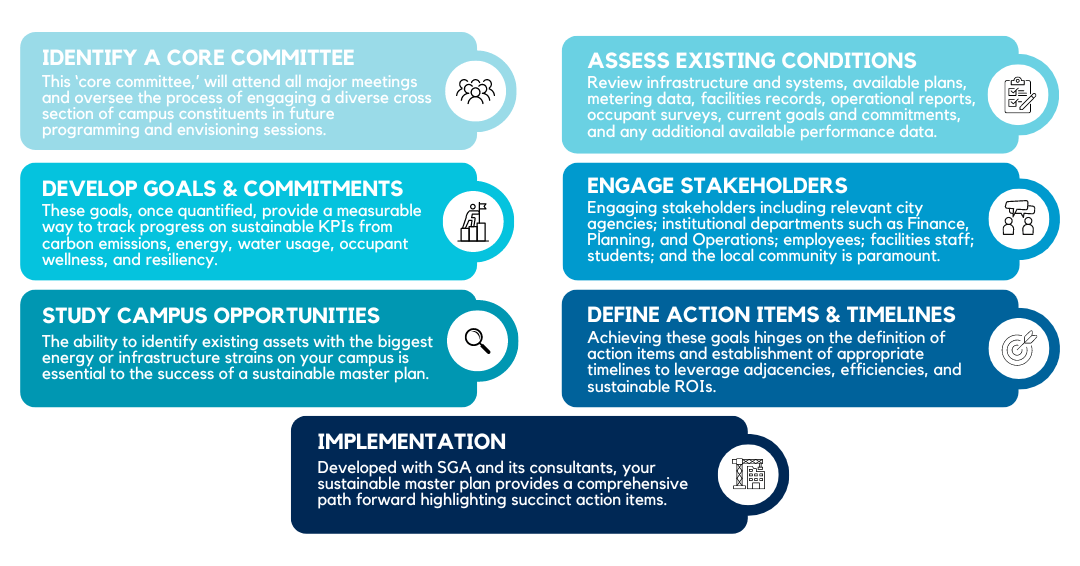
Identifying a Core Committee
It is imperative to create an internal strategic decision making team to guide and inform the process. This ‘core committee,’ will attend all major meetings and oversee the process of engaging a diverse cross section of campus constituents in future programming and envisioning sessions. Outlining the core decision making team early-on, and understanding institutional hierarchy, is critical to the process.
Assessing the Existing Condition
Before embarking on the journey, a detailed assessment of existing campus conditions is crucial. This involves reviewing infrastructure and systems, available plans, metering data, facilities records, operational reports, occupant surveys, current goals and commitments, and any additional available performance data. At this stage, SGA deploys digital twinning technologies to assist in the development of a baseline and standards that optimize tracking and reporting.
This assessment understands strengths, limitations, gaps, and opportunities to inform the targets that will be set and the strategies needed to meet institutional goals. This process provides a heat map of your campus – showing existing buildings, utilities, and infrastructure that are most in need of sustainable updates to inform decision making on how to address them. The assessment will also identify simple solutions that can be rolled out immediately with minimal budget and timeframe.
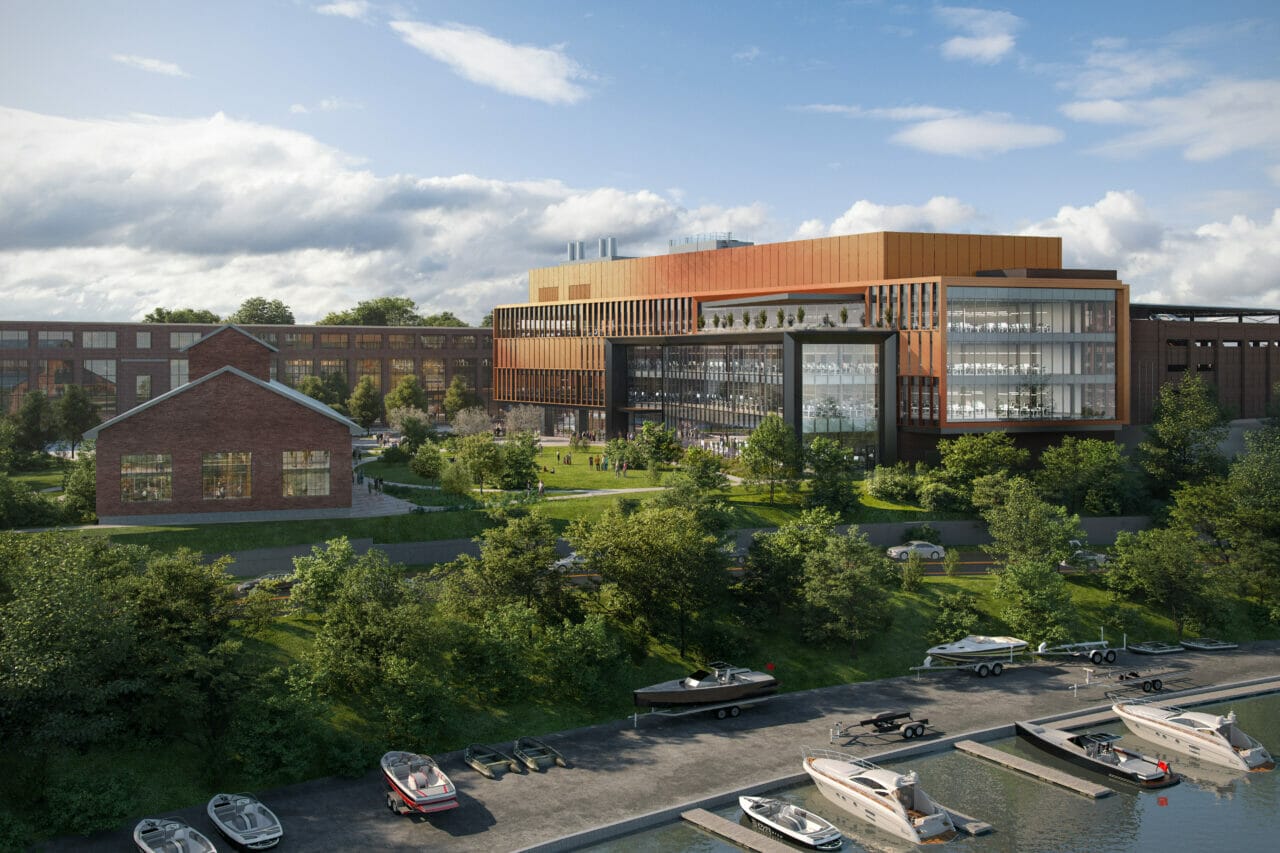
Developing Goals & Climate Commitments
The foundation of a sustainable master plan lies in developing goals and targets aligned with the institution’s vision and mission. These goals, once quantified, provide a measurable way to track progress internally and to report it externally.
In partnership with SGA and our consultants, the core committee will set quantifiable targets and timelines that align with climate commitments. This allows your institution to make sense of a complex and ever changing landscape of environmental policy and social awareness. By chartering a well rounded strategy and making meaningful progress on its implementation, your organization is poised to lead important conversations around the pertinence, feasibility, and human benefit of environmentally-conscious development. The following are some of the major factors that should be addressed by the design team and stakeholders when setting targets:
Carbon Emissions: Whether establishing a carbon-neutral target, or a broader operational objective, it is important to consider both embodied and operational carbon emissions. While prioritizing electrification strategies and pursuing industry-standard green certifications like LEED, Passive House, and Living Building Challenge are at the forefront of sustainable excellence right now, it is important to design with flexibility in mind. Continued innovation in the field presents boundless potential for future upgrades to keep operational carbon at a minimum. To reduce embodied carbon, targets should be created for the material used in the construction, and planning for circular design should be part of the standards in any master plan.
Energy Sources: Non-fossil fuel energy sources and renewable energy, in combination with energy storage strategies, are key factors for success. SGA continues to engage in conversations with leading engineering partners and institutions eager to capitalize on regionally available geothermal, wind, and solar capabilities. Ambitious yet feasible energy usage targets should be defined for each building typology in the master plan. It is also important to engrain adaptability into the design for your campus energy infrastructure. With future technological advancements already in the works, and yet to be discovered, SGA works to ensure their future integration is seamless.
Water usage: Whether establishing a zero-water target, or another operational objective, it is important to consider both low water usage fixtures, water reuse strategies, and stormwater management. Defined targets ensure all opportunities on campus are utilized to their fullest.
Occupant wellness: The health and wellbeing of your campus’ end users should be at the forefront of any planning initiative. Throughout any design process, standards for comfort and connection to the environment should be identified early-on to guide future decision making. Leveraging design to promote wellbeing, health, and the use of natural materials helps to inform targets and goals; such as opportunities for pursuing applicable certifications like WELL or fitwel.
Resiliency: Incorporating resiliency measures to ensure the built environment can withstand anticipated climate challenges is crucial. While sustainability focuses on reducing a campus’s impact on the environment, resiliency shifts the focus to reducing the environment’s impact on campus. Together, these distinct but inherently interconnected concepts are represented throughout an appropriately-equipped master plan. Proactive solutions that anticipate potential operational interruptions and safety concerns are critical when designing our built environment. Having completed many projects with the foresight of their unique evolving climate conditions, SGA’s expertise mitigates risk and helps to future-proof your institution’s assets.
Benchmarking has a crucial role in helping to define goals and targets throughout the planning process. Data collected should quantify campus resource use, embodied carbon, and occupant wellness to understand where the campus or institution ranks in comparison to its identified peers. This empowers owners and constituents to garner insight and make decisions that stay on track with their own goals and exceed achievements of peers.
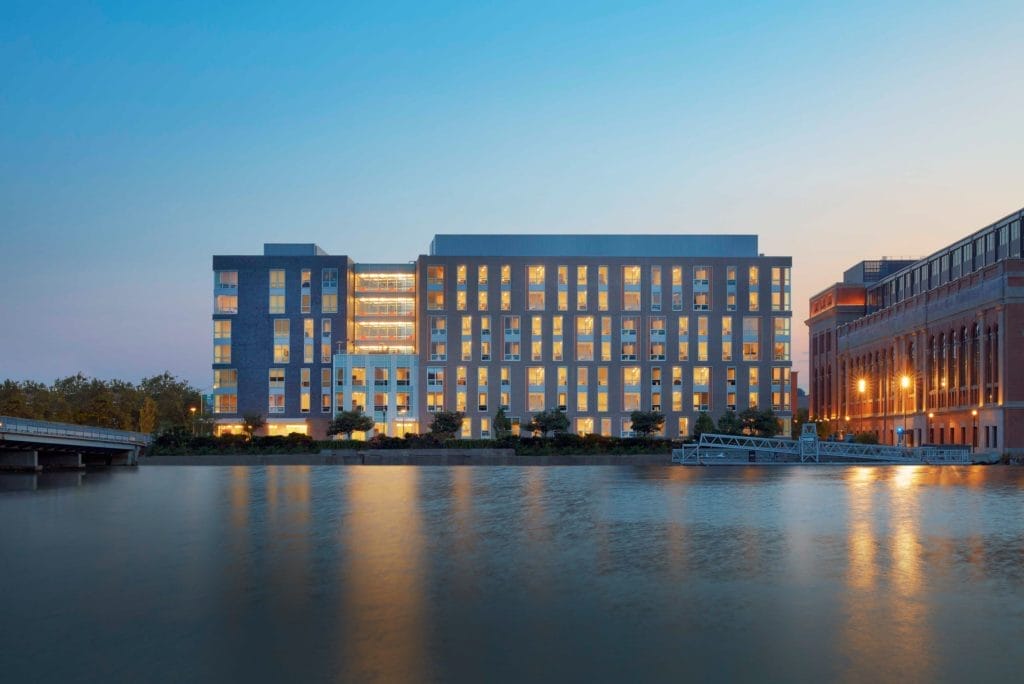
Engaging Stakeholders
Your core committee will lead decision making, and help to identify the broader audiences that will provide insight into your institution’s individual needs. Engaging stakeholders including relevant city agencies; institutional departments such as Finance, Planning, and Operations; employees; facilities staff; in an academic setting, students; and the local community is paramount. A strong stakeholder network ensures collaborative implementation.
Programming and envisioning sessions, surveys, and presentations with this broader group–led by your core committee and consultant team–will take your outlined goals and commitments and ideate opportunities to implement them on your specific campus.
Studying Opportunities Within Your campus
The ability to identify existing assets with the biggest energy or infrastructure strains on your campus is essential to the success of a sustainable master plan. Once identified, these assets are studied for potential renovation or adaptive reuse opportunities. With the primary goal being to enhance and expand existing building stock in a way that makes them more sustainable and functional, the demolition of an existing structure may be identified as a more effective solution to future sustainability objectives.
SGA continues to see unprecedented potential to refresh and reimagine existing spaces to meet increasing demand. There are often massive savings to embodied carbon in the reuse of an existing structure when compared to new construction. Primarily found in the reduced need for production and transportation of new materials, these projects also often require smaller construction teams.
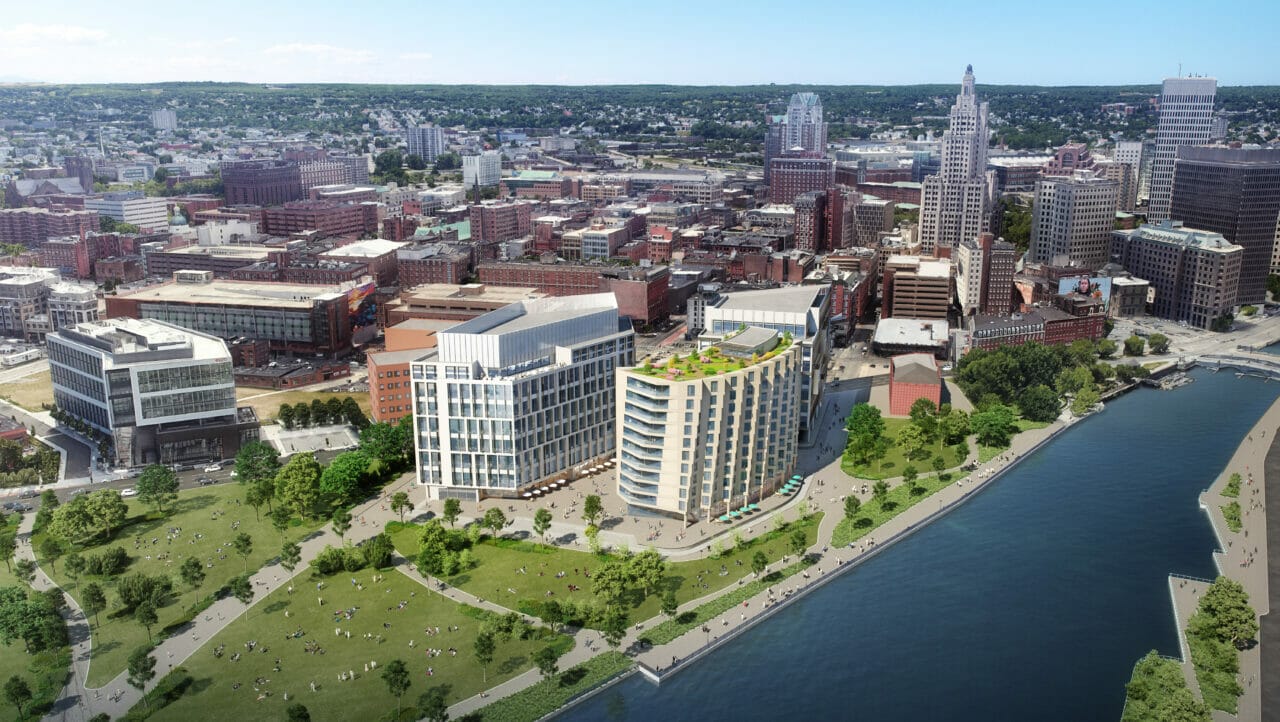
Site/Landscape
Infrastructure: Space planning for campus utilities, central plant/s, and new equipment and infrastructure (geothermal, thermal storage, solar, battery storage, redundancy components, etc.) is a major component of sustainable master planning. The potential site impacts associated with any of these strategies needs to be identified and the anticipated site permitting requirements outlined. This is not just in relation to new infrastructure, but also about rehabilitation, reuse, or optimization of existing infrastructure.
Water Conservation: Understanding and implementing water conservation opportunities to recapture rainwater and greywater for essential functions such as toilet flushing or landscape maintenance, as well as stormwater mitigation strategies, work to reduce the environmental load on the municipal systems with which your campus is connected.
Topography/Natural Resources: A comprehensive assessment of your campus will include indexing existing natural elements and features to ensure future capital improvement efforts preserve them as an asset. This thorough understanding of site constraints and opportunities will unlock potential to use the natural landscape in conjunction with building development, tap into potential geothermal capabilities, protect adjacent natural habitats, and identify resiliency opportunities.
Pedestrian-Friendly Campuses: Designing campuses to be pedestrian-friendly starts with introducing multimodal pathways to encourage walking, biking, and other green modes of transportation within the boundaries of your campus. This encourages commuters to leave their cars on the edges of campus and immerse themselves in the architectural and environmental vibrancy of your unique campus. Like much of a sustainable master plan, solutions to improve pedestrian-friendliness on your campus are incredibly unique to its individual characteristics.
Gardens and Outdoor Spaces: Integrating native and drought tolerant plantings throughout campus in the form of gardens and outdoor space is the foundation for climate appropriate landscaping. These green spaces lower the heat island effect, enhance biodiversity, and promote occupant wellness. These immersive environmental pockets are a great way to engage your immediate and surrounding community in the sustainability narrative on your campus.
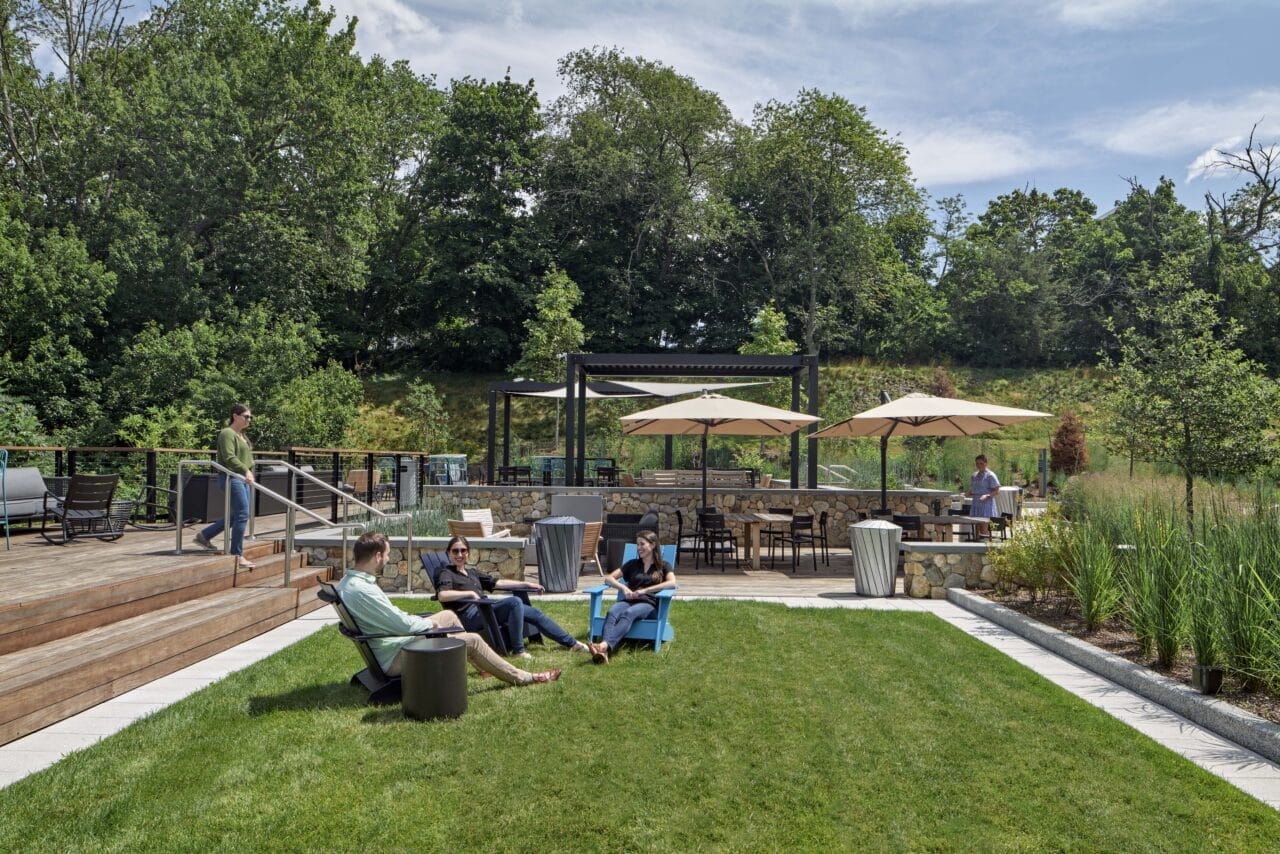
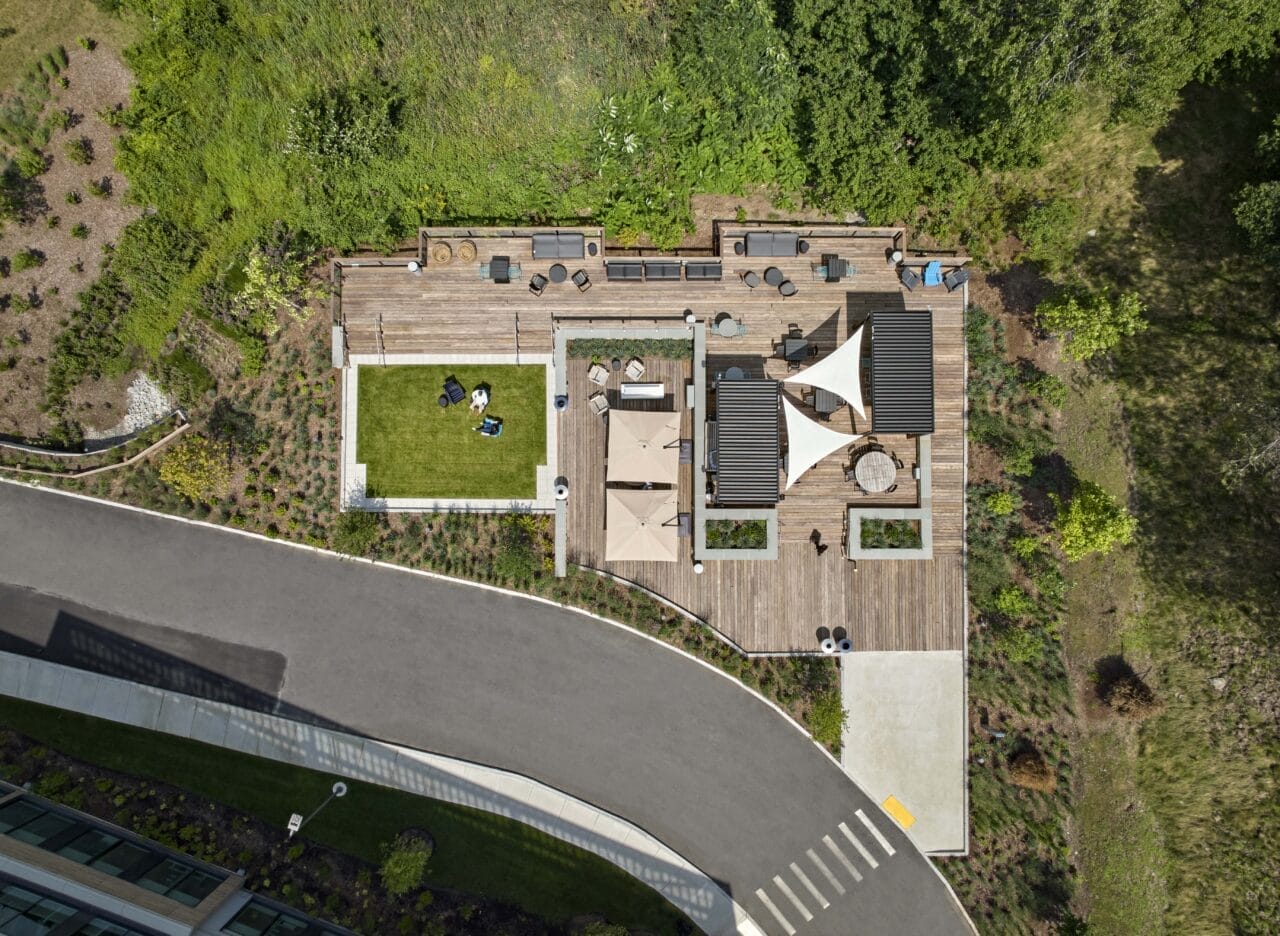
Building Opportunities
Envelope: Effectively a completed structure’s first line of defense against the external environment’s influence on the interior’s integrity, a highly-optimized building envelope sets the stage for a lifetime of energy efficiency. So, proper standards should be defined to guide the envelope design to improve thermal performance and occupant comfort.
MEP Infrastructure: The MEP (Mechanical, Electrical, Plumbing) infrastructure should align with the campus program and demand, using high performance fossil free technologies while planning for future flexibilities as they emerge. Efficiently planned MEP allows the project to minimize draw on the grid. This race to Net Zero energy use is a key tenant of these efforts. Additionally, technologies that use less water within HVAC systems are key additions to campus conservation.
Building Orientation: Building orientation should be studied in both existing buildings and new construction to ensure proper solar gain, daylight, and view. By understanding the solar orientation of your site, institutions are empowered to reconcile an existing structure’s load by integrating shading strategies as part of a facade refresh, intentional landscaping, or by strategically placing a new structure adjacent to the high-load building. Additionally, new buildings can be designed to use daylighting as an advantage by incorporating glazing on the appropriate facades to minimize glare, passively light spaces with natural light, and reduce solar heat gain.
Material: The use of low embodied carbon materials and processes, such as mass timber and low embodied carbon concrete, offer inherent sustainability benefits, aesthetic potential, and carbon reduction qualities. Sustainable interior materials should also be implemented to ensure the health, wellness, and comfort of occupants within these spaces. SGA’s experience leveraging the sustainability and wellbeing benefits of mass timber in innovative projects like 90 Arboretum and the Mass Timber Life Sciences Concept is applicable across markets and scales.
Waste Management and Recycling: Practices and procedures for ethical sourcing and removal of materials will be outlined from demolition through construction and post-occupancy – removing unnecessary waste from the environment. Easy access to composting and recycling is a simple way to immediately empower end users with firsthand engagement in the process of sustainable improvement.
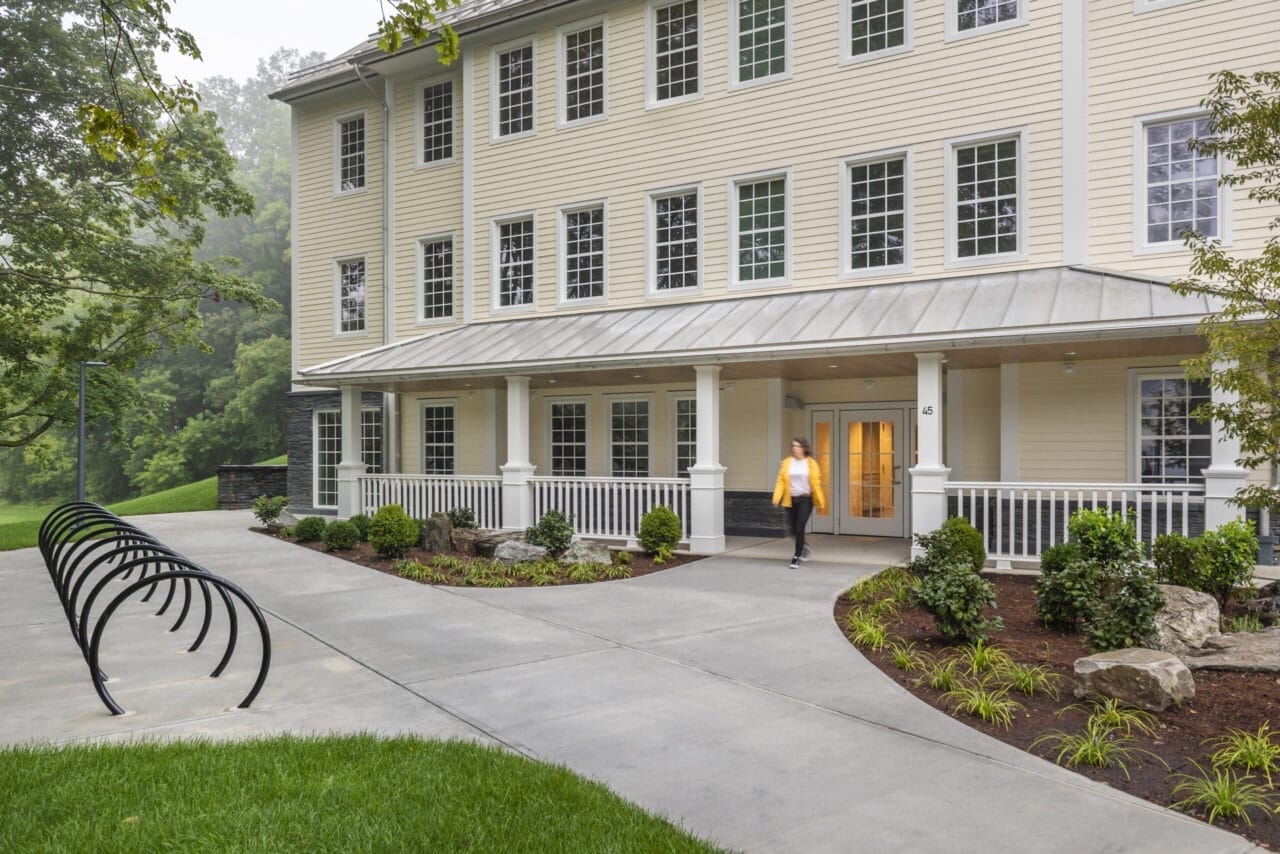
Sociocultural
Through intentional placemaking efforts, a focus on community-building, and design for wellbeing, a sustainable master plan provides inherent benefits to diversity, equity, and inclusion initiatives on campus. Easily aligning with organizational mission, vision, and action to further position your institution as a destination for diverse workforces and/or student bodies.
Defining Action Items, Timeline, and Preliminary Cost Estimating
Achieving these goals hinges on the definition of action items and establishment of appropriate timelines to leverage adjacencies, efficiencies, and sustainable ROIs. It is important to look at the cost of these efforts holistically. A sustainable master plan informs phased approaches, low investment initiatives, and identifies shorter-term projects that allow real estate and facilities to strategically implement upgrades. This living document also outlines standards for all future campus development that aligns with these goals and enhances your sustainable initiatives in an accelerated manner.
Bringing an experienced construction manager or cost estimator to the table early-on in the process allows SGA, its consultants, and your internal strategic decision making team to best plan for the timelines and associated cost of each action item. A knowledgeable team, SGA and its consultants are able to reflect any and all associated paybacks, grant, and incentives opportunities throughout preliminary cost estimating to help an institution meet its mission feasibly.
Implementation
Partnering with a qualified design team of campus planners, sustainability experts, and relevant consultants to implement these efforts provides your organization with the knowledge and tools to efficiently and effectively achieve institutional objectives and municipal mandates.
A decision-making matrix that includes all the sustainability action items discussed above, and their first cost and associated payback, is a necessary tool in this process to identify and rank solutions by their value from both cost, performance, and institutional benefit perspective. This allows your facilities and leadership teams to align the implementation of project opportunities in an informed, phased approach.
As we navigate the challenges of the modern world, these roadmaps provide clarity and action plans to achieve success in the built environment’s rapidly evolving approach to sustainability. Your SGA-designed sustainable master plan provides a comprehensive path forward highlighting succinct action items that streamline financial planning and achieve target implementation dates.
YOUR SUSTAINABLE MASTER PLANNING TEAM

Sadaf Jafari, CPHC, LEED® AP BD+C
Director of Sustainable Design
With a background in Architecture and Engineering, Sadaf’s holistic approach to design prioritizes the intricacies of each site to deliver custom-fit solutions that optimize sustainable performance. Sadaf is passionate about engaging communities in the important conversations around sustainability and resiliency.
Connect with Sadaf Jafari >

Lauren Gauthier, AIA, BSA
Director of Architecture
Inspired by the delivery of dynamic academic environments, Lauren’s expertise in educational design transcends markets as it is anchored by a passion for campus planning. Focused on improving wellness, diversity, equity, and inclusivity through design, Lauren’s penchant for enhancing interconnectivity elevates both academic and corporate landscapes.
Connect with Lauren Gauthier >
